
Bartolomeo Ammannati was an Italian architect and sculptor, born at Settignano, near Florence. He studied under Baccio Bandinelli and Jacopo Sansovino and closely imitated the style of Michelangelo.

Florence is a city in Central Italy and the capital city of the Tuscany region. It is the most populated city in Tuscany, with 383,083 inhabitants in 2016, and over 1,520,000 in its metropolitan area.

Donato di Niccolò di Betto Bardi, better known as Donatello, was a Florentine sculptor of the Renaissance period. Born in Florence, he studied classical sculpture and used this to develop a complete Renaissance style in sculpture. He spent time in other cities, and while there he worked on commissions and taught others; his periods in Rome, Padua, and Siena introduced to other parts of Italy his techniques, developed in the course of a long and productive career. Financed by Cosimo de' Medici, Donatello's David was the first freestanding nude male sculpture since antiquity.

Bartolommeo Bandinelli, actually Bartolommeo Brandini, was a Italian Renaissance sculptor, draughtsman, and painter.
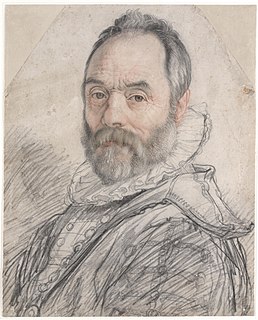
Giambologna — — was a Flemish sculptor based in Italy, celebrated for his marble and bronze statuary in a late Renaissance or Mannerist style.

The Boboli Gardens is a historical park of the city of Florence that was opened to the public in 1766. Originally designed for the Medici, it represents one of the first and most important examples of the Italian garden, which later served as inspiration for many European courts. The large green area is a real open-air museum with statues of various styles and periods, ancient and Renaissance that are distributed throughout the garden. It also has large fountains and caves, among them the splendid Buontalenti grotto built by the artist, architect, and sculptor Bernardo Buontalenti between 1536 and 1608.
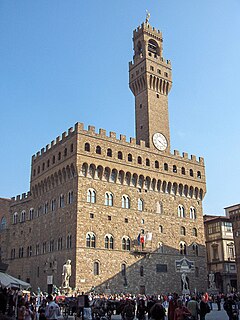
The Palazzo Vecchio is the town hall of Florence, Italy. It overlooks the Piazza della Signoria, which holds a copy of Michelangelo's David statue, and the gallery of statues in the adjacent Loggia dei Lanzi.

The Bargello, also known as the Palazzo del Bargello, Museo Nazionale del Bargello, or Palazzo del Popolo, was a former barracks and prison, now an art museum, in Florence, Italy.

Piazza della Signoria is a w-shaped square in front of the Palazzo Vecchio in Florence, Italy. It was named after the Palazzo della Signoria, also called Palazzo Vecchio. It is the main point of the origin and history of the Florentine Republic and still maintains its reputation as the political focus of the city. It is the meeting place of Florentines as well as the numerous tourists, located near Palazzo Vecchio and Piazza del Duomo and gateway to Uffizi Gallery.

The Loggia dei Lanzi, also called the Loggia della Signoria, is a building on a corner of the Piazza della Signoria in Florence, Italy, adjoining the Uffizi Gallery. It consists of wide arches open to the street. The arches rest on clustered pilasters with Corinthian capitals. The wide arches appealed so much to the Florentines that Michelangelo proposed that they should be continued all around the Piazza della Signoria.

A wax sculpture is a depiction made using a waxy substance. Often these are effigies, usually of a notable individual, but there are also death masks and scenes with many figures, mostly in relief.

Stradanus, Johannes Stradanus, Jan van der Straet or Giovanni Stradano was a Flemish artist active mainly in 16th-century Florence, Italy. He was a wide-ranging talent who worked as an easel and fresco painter, designer of tapestries, draughtsman, designer of prints and pottery decorator. His subject range was varied and included history subjects, mythological scenes, allegories, landscapes, genre scenes, portraits, architectural scenes and animals. After training in his native Flanders, he left his home country and ultimately settled down in Florence, Italy. He became a prominent court artist to the Medici during the second half of the 16th century and worked on the many decorative projects of the court. Stradanus also produced large altarpieces for the most important churches in Florence.

Giovanni Francesco (Gianfrancesco) Susini was a Mannerist Florentine sculptor in bronze and marble.
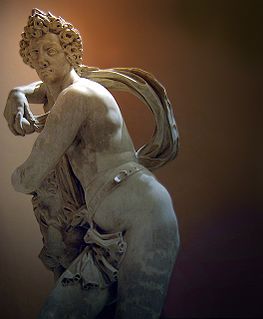
Pierre Franqueville, generally called Pietro Francavilla, was a Franco-Flemish sculptor trained in Florence, who provided sculpture for Italian and French patrons in the elegant Late Mannerist tradition established by Giambologna.
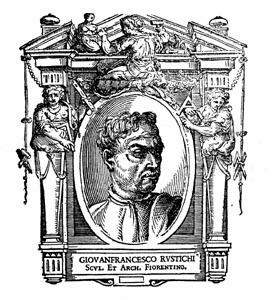
Giovan Francesco Rustici, or Giovanni Francesco Rustici, (1475–1554) was an Italian Renaissance painter and sculptor. He was born into a noble family of Florence, with an independent income. Rustici profited from study of the Medici sculpture in the garden at San Marco, and according to Giorgio Vasari, Lorenzo de' Medici placed him in the studio of Verrocchio, and that after Verrocchio's departure for Venice, he placed himself with Leonardo da Vinci, who had also trained in Verocchio's workshop. He shared lodgings with Leonardo while he was working on the bronze figures for the Florence Baptistry, for which he was ill paid and resolved, according to Vasari, not to work again on a public commission. Moreover, an echo of Leonardo's inspiration is unmistakable in the much-discussed and much-reviled wax bust of "Flora" in Berlin, ascribed to a circle of Leonardo and most probably to Rustici. At this time, Pomponius Gauricus, in De sculptura (1504), named him one of the principal sculptors of Tuscany, the peer of Benedetto da Maiano, Andrea Sansovino and Michelangelo. It may have been made in France, perhaps in the circle of Rustici, who entered Francis I's service in 1528.
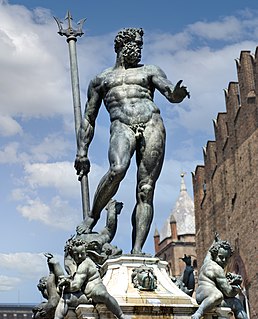
The Fountain of Neptune is a monumental civic fountain located in the eponymous square, Piazza del Nettuno, next to Piazza Maggiore, in Bologna, Italy The fountain is a model example of Mannerist taste of the Italian courtly elite in the mid-sixteenth century.

Perseus with the Head of Medusa is a bronze sculpture made by Benvenuto Cellini in the period 1545–1554. The sculpture stands on a square base which has bronze relief panels depicting the story of Perseus and Andromeda, similar to a predella on an altarpiece. It is located in the Loggia dei Lanzi in the Piazza della Signoria in Florence, Italy. The second Florentine duke, Duke Cosimo I de' Medici, commissioned the work with specific political connections to the other sculptural works in the piazza. When the piece was revealed to the public on 27 April 1554, Michelangelo's David, Bandinelli's Hercules and Cacus, and Donatello's Judith and Holofernes were already installed in the piazza.

The Fountain of Neptune in Florence, Italy, is situated in the Piazza della Signoria, in front of the Palazzo Vecchio. The fountain was commissioned by Cosimo I de' Medici in 1559 to celebrate the marriage of Francesco de' Medici I to Grand Duchess Joanna of Austria. Cosimo I de' Medici was the Duke of Florence from 1537-1569 and responsible for a vast number of architectural and artistic elements in Florence that still exist today.

Female Figure is a near life-size 16th century marble statue by the Flemish sculptor Giambologna. It measures 114.9 cm and depicts an unidentified woman who may be Bathsheba, Venus or another mythological person. The work dates from 1571 to 1573, early in the artist's career, and has been held by the J. Paul Getty Museum since 1982. The woman is nude save for a bracelet on her upper left arm and a discarded garment covering her lap. She sits on a column draped with cloths, holding a jar in one hand, drying her left foot with the other.

Italian Renaissance sculpture was an important part of the art of the Italian Renaissance, in the early stages arguably representing the leading edge. The example of Ancient Roman sculpture hung very heavily over it, both in terms of style and the uses to which sculpture was put. In complete contrast to painting, there were many surviving Roman sculptures around Italy, above all in Rome, and new ones were being excavated all the time, and keenly collected. Apart from a handful of major figures, especially Michelangelo and Donatello, it is today less well-known than Italian Renaissance painting, but this was not the case at the time.





















